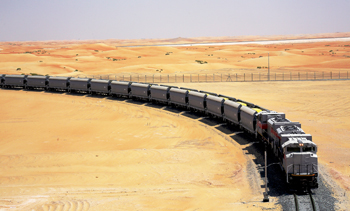The Big Middle East Report
The Middle East to benefit from 36,000km of new rail lines
The UAE’s Etihad Rail network alone will stretch over more than 2,100km when completed, connecting Bahrain, Kuwait, Oman, Qatar and Saudi Arabia

The 11th Meed Mena Rail & Metro Conference was held in Dubai last month from 5 to 7, under the patronage of Dr Abdullah Belhaif Al Nuaimi, minister of Public Works and chairman of the Federal Transport Authority of the UAE.
Industry leaders gathered to discuss and debate the opportunities and challenges that the Middle East and North Africa (Mena) region presents for the rail sector.Mideast railDuring the three-day event, it was revealed that a total of 36,000 kilometres of new railway, metro and light rail lines are planned in the Middle East compared to 19,970 kilometres that exist now. 'The total value of all projects planned or under construction in the Middle East is $427 billion,' Meed Projects director of content and analysis Ed James, says. 'Saudi Arabia, Turkey and Qatar are the biggest markets. But across the board, we are seeing very ambitious railway projects planned.'The largest planned project is the Riyadh-Dammam high speed project worth $14 billion, which is under study. Other major projects planned include Tehran Metro’s lines eight and nine, and four express lines. The Jeddah Metro is to be tendered by the end of this year.
GCC rail networkOfficials overseeing the construction of the GCC rail network, which will connect all six GCC countries, were scheduled to meet mid-last month to assess whether the project will have to be postponed or will be completed by 2018 as scheduled. The entire network when completed will span over 2,100 kilometres and will provide an alternative means of travel around the peninsula.The UAE is currently developing the Etihad Rail project, which will eventually connect with the rest of the GCC railway. The 1,200-kilometre line, originally planned to be completed in 2018, will link major industrial zones, cities and ports in the UAE. According to the UAE Minister of Public Works, the country has already built 264 kilometres of the 1,200-kilometre network across the UAE, from the border of Oman to the Saudi border.
BahrainBahrain is preparing to invite bids before the end of the year for the initial work on its proposed light rail network and how it will connect with the GCC railway. 'The next phase is to connect the GCC railway with Bahrain’s public transport network,' Bahrain’s Deputy Minister for Land and Post Mariam Jumaan, Undersecretary, Land transportation at the Ministry of Transportation and Telecommunications (Bahrain) said at the summit. 'We are looking at the possibility of light rail and we are going out to tender for consultancy for this project.'Jumaan said that that this will involve reviewing earlier studies about possible public transport modes in Bahrain. She said that neither a metro nor a tram system would work in Bahrain, which has limited available land. However, an elevated light rail network is possible: this could be a monorail, she added. Jumaan said that the feasibility study into options for expanding the King Fahad Causeway between Saudi Arabia and Bahrain commissioned from Canada’s SNC Lavalin will soon be completed. It will include recommendations about whether an expansion of the causeway should include the construction of a road-only link or one that supports both road and railway traffic. She said that once this has happened, construction of the causeway expansion can proceed.
JordanAmman is inviting investors to support a $300 million railway line between Amman and Amman Airport that will follow the alignment of the Hejaz Railway. The line will be 32 kilometres long and have 12 stations, Jordan Hejaz Railway deputy director Abdullah Malkawi said at the summit. He also said plans call for the line to be extended to Zarqa, Jordan’s second city.
QatarTests of the first part of the Doha Metro are due to start in the autumn of 2016, setting the scene for the full completions of the project’s $15-billion first phase in 2019. Louis Berger Egis Rail joint venture (LBERJV) project director Peter Housley said that the civil work in the 6-kilometre elevated and at grade section of Red Line South is due to be finished in less than one year’s time.
DubaiThe recent introduction of a new public-private partnership (PPP) law in Dubai increases the number of available options for funding infrastructure projects in, which have been traditionally financed wholly by the government.The first scheme that will be executed under the new PPP law is the Union Oasis, a mixed-use project to be built above the Dubai Metro’s Union Square station, which was conceived by the Dubai Roads and Transport Authority (RTA). The RTA has planned as early as in 2011 to tap private funds for 30 per cent of its projects. The Union Oasis towers will be built based on the new law’s recommended 30-year concession agreements.Dubai’s adoption of a new horizontal PPP law follows after the implementation of similar laws in Kuwait and Bahrain. It also paves the way for similar laws to be introduced across the region.Qatar is currently seeking advisors in a bid to develop its own PPP framework, while Oman is understood to be considering the adoption of PPP for some segments of its national railway project.
